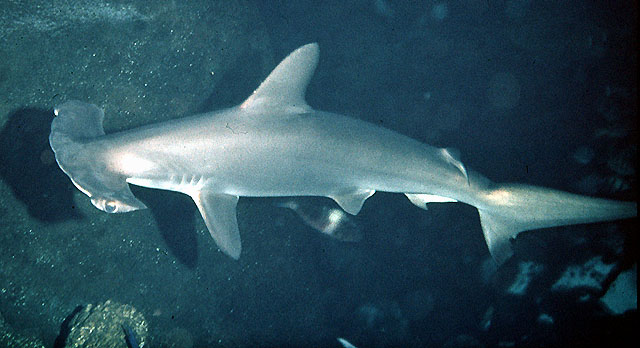| Sphyrnidae (Hammerhead, bonnethead, or scoophead sharks) |
| 430 cm TL (male/unsexed); max.weight: 152 kg; max. reported age: 35 years |
|
pelagic-oceanic; depth range 0 - 1000 m, oceanodromous |
| Circumglobal in coastal warm temperate and tropical seas (Ref. 13562). Western Atlantic: New Jersey, USA to Uruguay (Ref. 58839), including the Gulf of Mexico and Caribbean. Eastern Atlantic: western Mediterranean (Ref. 6678) to Namibia (Ref. 6812). Indo-Pacific: Persian Gulf (Ref. 68964), Red Sea, East Africa and throughout the Indian Ocean; Japan to New Caledonia, Hawaii and Tahiti. Eastern Pacific: southern California, USA to Ecuador, probably Peru. |
|
Dorsal spines (total): 0-0; Dorsal soft rays (total): 0-0; Anal spines: 0-0; Anal soft rays: 0-0. A large hammerhead with a notch at the center of head; 1st dorsal fin moderately high, 2nd dorsal and pelvic fins low (Ref. 5578). Front margin of head broadly arched with prominent median notch. Side wings of head narrow, rear margins swept backward (Ref. 26938). Uniform grey, grayish brown, or olivaceous above, shading to white below; pectoral fins tipped with grey or black ventrally (Ref. 13562). |
| A coastal-pelagic, semi-oceanic shark occurring over continental and insular shelves and adjacent deep water, often approaching close inshore and entering enclosed bays and estuaries (Ref. 244, 11230, 58302). Found in inshore and offshore waters to about 275 m depth (Ref. 26938, 11230, 58302); has been filmed at a baited camera in 512 m depth (Lis Maclaren, pers. comm. 2005). Huge schools of small migrating individuals move pole ward in the summer in certain areas (Ref. 244). Permanent resident populations also exist (Ref. 244). Juveniles occur in coastal areas (Ref. 58784). Adults solitary, in pairs, or schools; young in large schools (Ref. 13562). Feed mainly on teleost fishes and cephalopods (Ref. 6871), also lobsters, shrimps, crabs (Ref. 30573), including other sharks and rays (Ref. 37816). Viviparous (Ref. 50449). Mature females produce 15-31, of 43-55 cm young in a litter (Ref. 26938, 1602). Considered potentially dangerous to people but often not aggressive when approached by divers (Ref. 13562). Readily available to inshore artisanal and small commercial fisheries as well as to offshore operations (Ref. 13562). Sold fresh, dried-salted, smoked and frozen; also sought for its fins and hides (Ref. 9987). Oil used for vitamins and carcasses for fishmeal (Ref. 13562). |
|
Endangered (A2bd+4bd)
(Ref. 96402)
|
| other |
|
Source and more info: www.fishbase.org. For personal, classroom, and other internal use only. Not for publication.
Page created by Jen, 05.08.02,
php script by kbanasihan 06/09/2010 ,
last modified by
dsantos, 20/08/10

